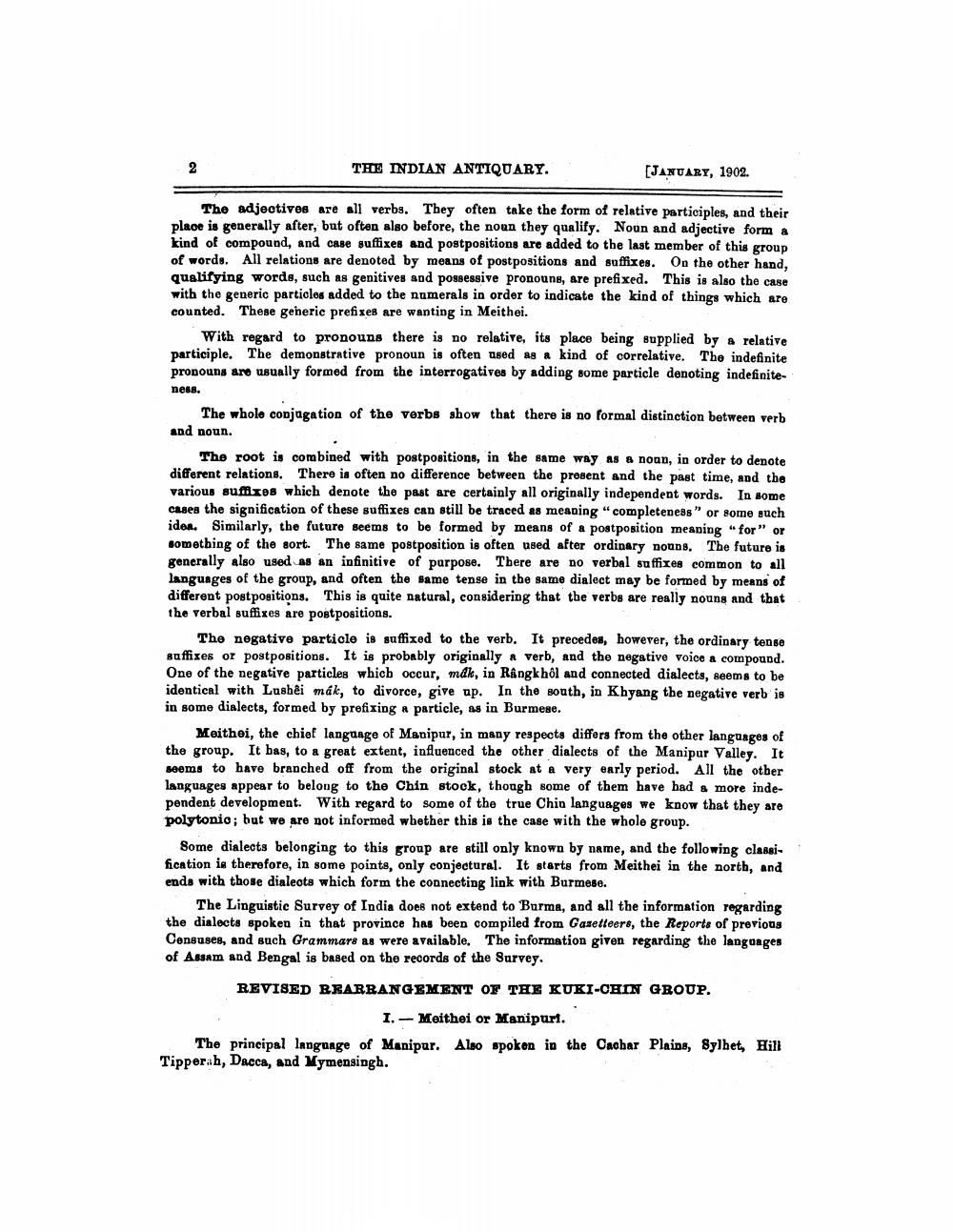________________
THE INDIAN ANTIQUARY.
[JANUARY, 1902.
The adjectives are all verbs. They often take the form of relative participles, and their place is generally after, but often also before, the noun they qualify. Noun and adjective form a kind of compound, and case suffixes and postpositions are added to the last member of this group of words. All relations are denoted by means of postpositions and suffixes. On the other hand, qualifying words, such as genitives and possessive pronouns, are prefixed. This is also the case with the generic particles added to the numerals in order to indicate the kind of things which are counted. These generic prefixes are wanting in Meithei.
With regard to pronouns there is no relative, its place being supplied by a relative participle. The demonstrative pronoun is often used as a kind of correlative. The indefinite pronouns are usually formed from the interrogatives by adding some particle denoting indefiniteness.
The wholo conjagation of the verbs show that there is no formal distinction between verb and noun.
The root is combined with postpositions, in the same way as a noun, in order to denote different relations. There is often no difference between the present and the past time, and the various suffixos which denote the past are certainly all originally independent words. In some cases the signification of these suffixes can still be traced as meaning "completeness" or some such idea. Similarly, the future seems to be formed by means of a postposition meaning " for " or something of the sort. The same postposition is often used after ordinary nouns. The future is generally also used as an infinitive of parpose. There are no verbal suffixes common to all languages of the group, and often the same tense in the same dialect may be formed by means of different postpositions. This is quite natural, considering that the verbs are really nouns and that the verbal suffixes are postpositions.
The negative particle is suffixed to the verb. It precedes, however, the ordinary tense suffixes or postpositions. It is probably originally a verb, and the negative voice a compound. One of the negative particles which occur, mdk, in Rângkhôl and connected dialects, seems to be identical with Lushểi mák, to divorce, give up. In the south, in Khyang the negative verb is in some dialects, formed by prefixing a particle, as in Burmese.
Meithei, the chief language of Manipur, in many respects differs from the other languages of the group. It bas, to a great extent, influenced the other dialects of the Manipur Valley. It seems to have branched off from the original stock at a very early period. All the other languages appear to belong to the Chin stock, though some of them have had more independent development. With regard to some of the true Chin languages we know that they are polytonio; but we are not informed whether this is the case with the whole group.
Some dialects belonging to this group are still only known by name, and the following classification is therefore, in some points, only conjectural. It starts from Meithei in the north, and ends with those dialects which form the connecting link with Burmese.
The Linguistic Survey of India does not extend to Burma, and all the information regarding the dialects spoken in that province has been compiled from Gazetteers, the Reports of previous Censuses, and such Grammars as were available. The information given regarding the languages of Assam and Bengal is based on the records of the Survey.
REVISED BRARRANGEMENT OF THE KUKI-CHIN GROUP.
I. - Meithei or Manipuri. The principal language of Manipur. Also spoken in the Cachar Plains, Sylhet, Hill Tipperah, Dacca, and Mymensingh.




